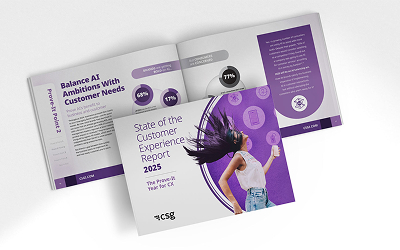Think about the last time you opened a bill. Maybe it was for electricity, your phone or a streaming service. Did it make sense right away? Did you feel confident you knew what you owed, why you owed it and how to pay? Or did you have to pause, re-read the fine print and second-guess whether the number at the bottom was right?
Bills are supposed to be straightforward. They exist for one simple reason: to communicate what’s owed and provide a way to pay. Yet for many people, receiving a bill is an exercise in confusion, doubt or frustration.
For tolling agencies, this matters more than we often admit. The invoice isn’t just paperwork. It may be the single most important touchpoint with drivers—the only communication they ever see. That single moment of clarity (or confusion) influences not only how quickly people pay but also how they feel about the entire tolling system.
So let’s pause and ask a simple, provocative question: When was the last time you received a bill that made you want to pay it?
Why Bills Are Experiences, Not Just Notices
Bills are often treated as a back-office function. They’re the end of a process: traffic passes a gantry, cameras capture plates, systems calculate charges and out goes a notice.
But from the driver’s point of view, the bill is not the end of a process—it’s the beginning of an experience. It’s the first time they see what tolling means for them personally.
Behavioral economics tells us that customers act faster when information is:
- Clear: Simple language, clean layout and logical order.
- Relevant: Specific to their context—like trip history or location.
- Actionable: Offering a straightforward next step, not a maze of instructions.
When a bill lacks those qualities, payment slows down. Some drivers ignore the bill altogether. Others set it aside until they “have time to figure it out.” Each delay translates into higher collection costs, longer revenue cycles and more driver frustration.
The Experience Test: Would You Pay Your Own Bill?
Here’s a practical test: take the driver journey yourself. Pretend you’re a first-time driver receiving a toll invoice in the mail or digitally.
- Do you understand the charges right away?
- Do you trust the accuracy of the invoice?
- Is it obvious how and where to pay?
- How many steps does it take to complete payment?
- Do you encounter unnecessary roadblocks like repeated logins, hard-to-find account numbers or jargon-filled instructions?
Many agencies are surprised when they do this exercise. What looks obvious internally often feels convoluted externally. And if you, as an insider, hesitate at any point, imagine what happens to a customer who doesn’t know your systems or terminology.
Bills That Build Trust vs. Bills That Create Doubt
Bills do more than collect money—they shape trust. A clear, well-designed invoice sends a subtle but powerful message: we are transparent, accurate and easy to work with. A confusing invoice does the opposite.
- Trust-building bills: Itemized charges, plain language, consistent branding, easy payment instructions, multiple payment options.
- Trust-eroding bills: Dense text, unexplained fees, conflicting instructions, poorly translated language or hard-to-use portals.
Drivers who trust the invoice are far more likely to pay quickly. Drivers who doubt it may delay, dispute or simply ignore it.
What Other Industries Have Learned
This isn’t just a tolling issue. Utilities, banks and subscription companies have all wrestled with the impact of billing on customer experience. Many have made progress.
- Utilities: Power companies once mailed dense paper statements. Today, many offer interactive e-bills where customers can see usage graphs, compare months and pay with one click.
- Telecom: Mobile providers use clear breakdowns of data, voice and text, often with color-coded visuals.
- Streaming services: Platforms like Netflix avoid invoices altogether by defaulting to seamless auto-pay subscriptions.
These industries have realized that bills aren’t administrative—they’re strategic. They influence loyalty, trust, and revenue flow. Tolling agencies face the same opportunity.
The Cost of Confusion
It’s tempting to think invoice design is cosmetic. But the financial impact is real. Consider:
- Delayed payments: Each day of delay ties up working capital.
- Increased collection costs: More reminders, notices or even enforcement.
- Higher call center volume: Drivers call when they don’t understand a bill, straining agency resources.
- Reduced compliance: Confused customers are less likely to pay at all, increasing write-offs or legal processes.
Clarity isn’t just good design—it’s good business.
Where Agencies Can Start
Improving bills doesn’t require massive technology overhauls. Some of the biggest wins come from small, intentional changes:
- Language: Replace jargon with plain English. The phrase “Administrative fee for account processing” could be simplified to “Service fee.”
- Design: Use hierarchy—bold amounts due, clear deadlines and concise instructions.
- Channels: Offer both digital and paper options, recognizing customer diversity.
- Accessibility: Provide translations, larger fonts and screen-reader compatibility.
- Consistency: Ensure your brand voice and visual identity are the same across the website, invoice and payment portal.
The Role of Empathy
At the heart of this conversation is empathy. Agencies need to see bills not as outputs of a system but as inputs into a customer relationship.
Imagine a driver who only encounters your agency through a bill. What impression are they left with? Do they feel like a valued customer, or like a violator being penalized?
The difference often lies in the tone and clarity of the invoice.
Asking the Hard Questions
To challenge convention, agencies need to ask:
- What do customers feel when they receive our invoices?
- Would we pay this bill if it came from another agency?
- What instructions or design elements are helping—or hurting—the journey?
- Where are we creating friction that slows down payments?
- Are our assumptions about customers’ technology and literacy accurate?
- If we operated like a retailer, how would this bill look different?
Why This Matters for the Future of Mobility
As tolling integrates with broader mobility services—parking, transit, ridesharing—the driver’s expectations will only rise. Agencies that fail to modernize billing risk not just slower revenue but reputational damage.
On the other hand, agencies that treat billing as customer experience will be better positioned to:
- Collect faster.
- Reduce operational costs.
- Strengthen public trust.
- Adapt to integrated, digital-first mobility ecosystems.
The Provocative Question
So let’s come back to the beginning: When was the last time you received a notice that made you want to pay it?
If you can’t think of one, maybe that’s the opportunity in front of us. Tolling agencies don’t have to accept confusing bills as the norm. They can choose to create experiences that are clear, convenient and trustworthy.
And when they do, they won’t just be collecting money. They’ll be building relationships, accelerating revenue and shaping the future of mobility one invoice at a time.
Streamline customer communications from notice to payment
CSG powers omnichannel print, digital, and payments experiences purpose-built for tolling agencies.











